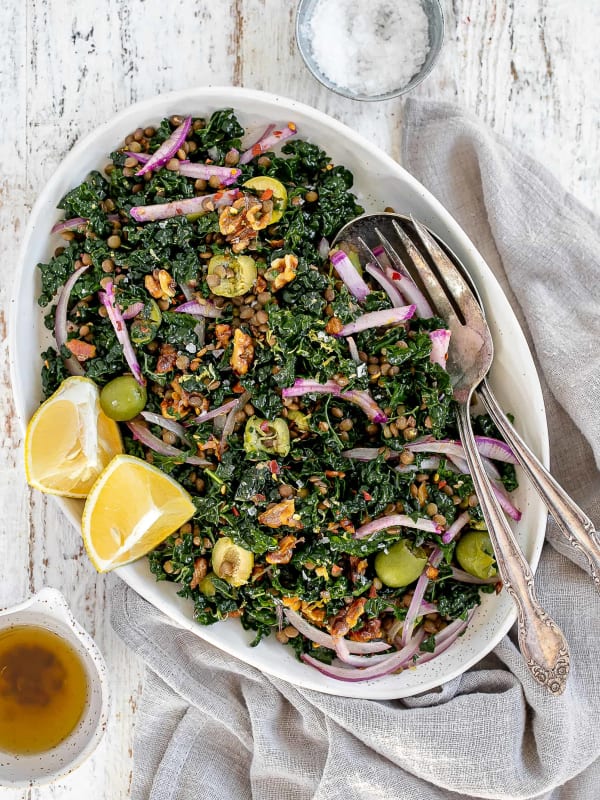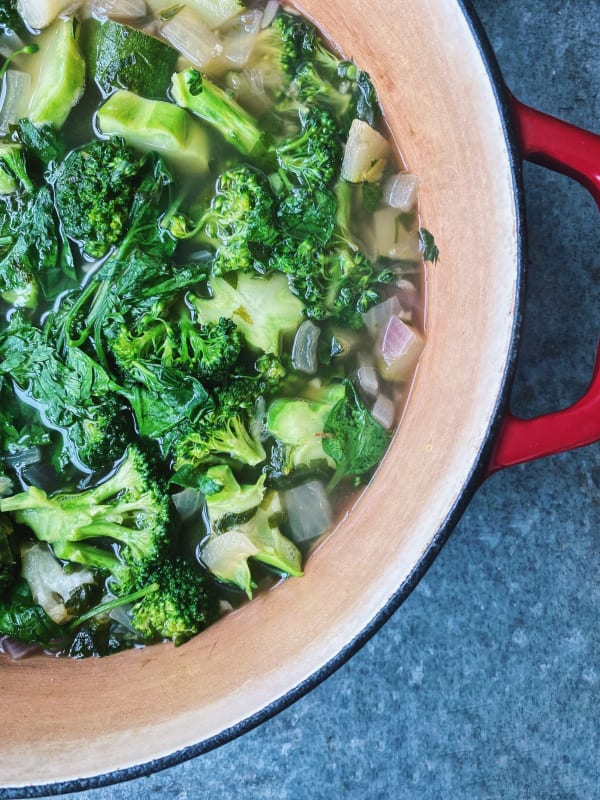Brassicas: These Veggies Are Not Like The Rest

Brassicas: These Veggies Are Not Like The Rest
Learn why cruciferous veggies are the superfoods you can’t ignore.
Cruciferous vegetables aren’t just your average greens- they’re extreme next-level nutritional powerhouses that can dramatically improve and extend your life. But what exactly are cruciferous vegetables, and what sets them apart?
We’ve all been told to eat our veggies. However, among all the greens, reds, yellows and purples of the produce section, a family stands alone in its outstanding ability to massively increase our well-being. That remarkable group is known as the cruciferous or Brassicaceae family. So-called because their four-petaled flowers resemble a cross or crucifix, cruciferous plants encompass a broad range of common veggies like broccoli, Brussels sprouts, and cabbage that you’re undoubtedly familiar with. What you may not be aware of is what makes these brassicas so brilliant. By the end of this short article, you’ll know what they are, the nuances between different types, and why you might want them on your plate!
Shared Roots
Today, cruciferous veggies are so diverse, from purple romanesco to curly green kale, that most people don’t realize they are related. But their story begins with a single ancestor plant thought to have grown in the Mediterranean region thousands of years ago. The humble wild mustard green (Brassica oleracea) was selectively cultivated for different features, resulting in the tremendously varied array of vegetables we now enjoy. Farmers seeking larger leaves developed what would become kale and collards, while those favouring tight, compact flower buds created the progenitors of broccoli and cauliflower. After many generations, this one-parent veggie gave rise to an extended family of over 40 distinctly different nutritional superstars, each with unique flavours, textures, and health benefits.
The Chemistry Is The Key
The most important thing to understand about what truly sets brassicas apart is that they contain very important phytochemicals that aren’t found anywhere else. Here’s a quick breakdown of what makes the family so extraordinary:

Glucosinolates: These sulphur-containing compounds are responsible for the distinctive sharp flavour of many cruciferous vegetables. They are stored separately in plant cells from an enzyme called myrosinase, and when the vegetable is chewed, chopped, cooked, or otherwise physically compromised, the enzyme begins converting these glucosinolates into a wide range of metabolites, including isothiocyanates and indoles. This is a protective response designed to fend off herbivores, bacteria, and other pests. But it just so happens that in humans, this defensive chemical cascade is extremely beneficial.
Sulforaphane: Perhaps the most famous superstar isothiocyanate, sulforaphane is renowned for its powerful antioxidant and proven toxin-neutralizing properties. It works by activating our own cellular machinery, specifically the ‘Keap1-Nrf2’ pathway. When engaged, a tidal wave of healthy chemicals is unleashed, including the all-important master antioxidant glutathione, along with a host of powerful detoxification enzymes. So, while we often talk about eating fruits and veggies that contain antioxidants, the real reason cruciferous plants are so impactful is related to our own physiological response to eating them. Just like a small pebble can cause ripples across the surface of a whole pond, a little bit of sulforaphane causes an exponential chain reaction throughout the body.

Indole-3-Carbinol (I3C): Found in abundance in cabbage, kale, and broccoli, indole-3-carbinol is also converted from glucosinolates. A well-established ally in hormone balance, I3C plays a critical role in modulating estrogen metabolism, steering it towards protective biochemical pathways that produce less potentially harmful estrogen metabolites. This well-documented effect makes it particularly noteworthy for reducing the risk of hormone-related cancers, such as breast and prostate cancer. Additionally, I3C is being studied for its ability to support detoxification, as it can enhance the activity of liver enzymes involved in neutralizing and excreting toxins.
Diindolylmethane (DIM): When indole-3-carbinol comes into contact with stomach acid, it converts to the extremely potent DIM or diindolylmethane. Known for its ability to fine-tune estrogen balance, DIM supports the breakdown of harmful estrogen derivatives while encouraging the production of beneficial forms. This dual action helps protect against conditions linked to estrogen dominance. Taken commonly as a supplement, DIM is probably the most powerful estrogen-balancing element that exists in the natural world. Beyond its hormonal effects, DIM has demonstrated anti-inflammatory, antioxidant, and even anti-cancer properties in scientific studies.
Astounding Brassica Benefits
Cancer Prevention: If there is a single reason why brassicas are so prized, it’s undoubtedly cancer prevention. One of the leading causes of death, cancer-related deaths are expected to increase 100 per cent by the year 2030. Cruciferous veggies help by multiple pathways, protecting DNA from oxidative damage, deactivating cancer-causing toxins, disabling viruses and bacteria, and regulating healthy cell component recycling (autophagy) and healthy cell death (apoptosis). A huge umbrella 2024 review of 22 meta-analyses, including 175 cancer studies, concluded that eating cruciferous veggies is associated with a significantly lower risk of nine different types of cancer, with the link to gastrointestinal cancers being particularly strong. Even less than a serving a day may decrease cancer progression risk by 50 per cent, and eating them just once a week might offer significant protection. In general, the more, the better.
Cardiometabolic Protection: In the 10-year Shanghai Women’s Health Study, those who ate the most cruciferous veggies had 22 per cent lower all-cause mortality than those who ate the least, and 31 per cent reduced CVD mortality risk. Sulforaphane, specifically, has been shown to reduce diabetes-induced hypertension and cardiac dysfunction. A meta-analysis accounting for over 750,000 people found that high consumption of brassicas was associated with a 13 per cent lower risk of type 2 diabetes, itself a leading cause of heart complications. Broccoli sprout powders and extracts (superlative sources of sulforaphane) have been shown in multiple placebo-controlled trials to reduce fasting insulin, improve insulin resistance, lower fasting glucose and HbA1c, and improve overall glycemic control. One study has found that eating kale, cauliflower, broccoli, and kale daily is significantly more effective at lowering blood pressure than potatoes, pumpkin, sweet potatoes or carrots.
Detoxification: Any food containing a significant helping of fibre will clean the colon like a sponge, helping to escort toxic material and excess hormones out of the body. But cruciferous compounds take detoxification support to a whole other level. This principle was demonstrated beautifully in a 12-week controlled trial on almost 400 adults in a highly polluted area of China. The study compared one group taking a placebo to another drinking a broccoli sprout juice rich in sulforaphane. Those who drank the cruciferous drink were able to pee out significantly more air pollution products, benzene and acrolein (also common to cigarette smoke), compared to the placebo group. Brassicas have also been found to protect the liver from non-alcoholic fatty liver disease. They stop the liver from storing fat, activate powerful detoxification enzymes, and keep it safe from inflammatory damage.
Neurological Benefits: On top of everything else, the amazing chemical cocktail of cruciferous compounds may also be valuable in protecting and healing the brain. It is thought to achieve broad mental health benefits by diminishing neuroinflammation via multiple separate mechanisms simultaneously, including inhibition of NF-kB, the body’s internal inflammation ‘on switch.’ This ability to stop inflammatory and oxidative damage to neurons shows massive potential for helping to prevent and even treat a wide variety of neurological and psychiatric conditions. Sulforaphane shows great potential benefit in particular and is being actively studied for depression, schizophrenia, anxiety, Parkinson’s, Alzheimer’s, and more. A randomized controlled trial on autistic boys found that only a few weeks of daily sulforaphane supplementation improved social function, behaviour and communication.

Broccoli: Highest in glucosinolates of them all, and famous for sulforaphane, broccoli supports detoxification and may seriously reduce cancer risk. It can be 10-100 times higher in broccoli sprouts.
Cauliflower: A versatile, low-carb option packed with brain-loving choline. It’s also high in prebiotics and a good source of heart-healthy, anti-aging resveratrol.
Kale: Loaded with fibre, vitamins C and K, beta-carotene, iron and other minerals. Highest in lutein and zeaxanthin, and extremely high in sulforaphane as well.
Arugula: A peppery low-oxalate green that is very rich in calcium, magnesium, and nitrates, which support blood pressure regulation. Highly nutrient-dense and packed with resveratrol.
Brussels Sprouts: High in fibre and sulforaphane, great for digestion and detoxification, and highest in potassium of all brassicas.
Cabbage: Excellent for gut health, containing several compounds that help heal the stomach lining. Cabbage is anti-inflammatory, nutrient-dense, and supports healthy bones.
Mustard Greens: Packed with vitamins A, C, and K, great for immunity and cardiac health. Mustard greens are bursting with antioxidants and fibre and even contain omega-3 fatty acids.
Radishes: Chock full of first-class fibre and loaded with powerful compounds that boost bile flow and support liver function and detoxification.
Turnips: A great source of vitamin C, vitamin K and lutein, turnips are fantastic for cardiovascular health. Supremely gut-healthy, they are richly endowed with prebiotics and natural antibiotics.
Rutabaga: A hybrid of turnips and cabbage, rutabagas are rich in potassium and fibre for heart health. They are also excellent for regulating bowel function.
Bok Choy: A Chinese cabbage variant, bok choy is low in oxalates and loaded with calcium for bone strength and vitamin A for vision. It also contains copper and zinc.
Collard Greens: High in fibre and a great source of folate. Also loaded with vitamin K, calcium, and beta-carotene, collards are extremely nutrient dense and packed with antioxidants.

Watercress: Jam-packed with vitamins and minerals, watercress does it all. It’s loaded with potassium and high-power antioxidants like resveratrol, lutein, and zeaxanthin.
Horseradish: This unique, pungent superstar contains compounds that help clear sinuses and boost immunity. It’s highest in zinc and selenium among the whole cruciferous family and is powerfully antibacterial and anti-inflammatory.
Wasabi: Nicknamed “Japanese horseradish,” wasabi is high in isothiocyanates with potential anti-cancer properties. It shares many benefits with horseradish but also features 6-MSITC. This unique anti-inflammatory compound is extremely good for the brain.
Chinese Broccoli (Gai Lan): High in antioxidants and an amazing source of calcium and iron. It’s also high in sulforaphane and incredibly supportive of the immune system.
Romanesco: A visually striking cousin of cauliflower, romanesco is even richer in vitamin C and fibre. Its green colour (in some cases) also reveals a source of chlorophyll and carotenoids like lutein and zeaxanthin.
Daikon Radish: Majorly supports bile flow, digestion, and kidney health. Daikon is also useful in helping to improve respiratory function.
Broccolini: A hybrid of broccoli and Chinese broccoli, broccolini offers similar benefits with a milder flavour. It can even help balance blood pressure and bowel function.
Mizuna: A Japanese mustard green with anti-inflammatory properties. Mizuna is chock full of vitamin K for healthy blood, healthy bones, and healthy hearts.
Kohlrabi: A lesser-known member of the family, kohlrabi is remarkably rich in vitamin C and potassium. It’s also among the highest in glucosinolates of them all.
Culinary Cruciferous Considerations
The cooking method is a crucial consideration when eating cruciferous veggies for health. Boiling can lead to an 80 per cent reduction in glucosinolate content. Steaming for up to 20 minutes, stir-frying for five minutes or less, or microwaving for three minutes, however, doesn’t reduce glucosinolate content at all. Eating cruciferous veggies fresh is great for getting the most out of them, and refrigerating them will keep their chemistry intact for up to a week. Fresh, raw sprouts are the way to go to really maximize your glucosinolate and sulforaphane intake.
But glucosinolates and isothiocyanates like sulforaphane are not nearly all brassicas have to offer. They’re potent bundles of antioxidants like carotenoids like beta-carotene, zeaxanthin and lutein, anthocyanins, flavonoids, enzymes, minerals like potassium, selenium and calcium, soluble and insoluble fibre, and vitamins E, C, and K. It’s no wonder they’re so profoundly beneficial for health in general, and the gut in particular.
However you enjoy them, incorporating a variety of cruciferous vegetables into your diet can help you feel younger, fight off disease, and live a longer, healthier life. Whether you’re looking to reduce inflammation, protect your liver, or get more nutrients, these super-veggies deserve an exalted place in the shopping cart and on the plate. And, of course, it doesn’t hurt that they are absolutely delicious.
Auborn, K. J., Fan, S., Rosen, E. M., Goodwin, L., Chandraskaren, A., Williams, D. E., Chen, D., & Carter, T. H. (2003). Indole-3-carbinol is a negative regulator of estrogen. The Journal of Nutrition, 133(7). https://doi.org/10.1093/jn/133.7.2470s
Ağagündüz, D., Şahin, T. Ö., Yılmaz, B., Ekenci, K. D., Duyar Özer, Ş., & Capasso, R. (2022). Cruciferous vegetables and their bioactive metabolites: From prevention to novel therapies of colorectal cancer. Evidence-Based Complementary and Alternative Medicine, 2022, 1–20. https://doi.org/10.1155/2022/1534083
Connolly, E. L., Sim, M., Travica, N., Marx, W., Beasy, G., Lynch, G. S., Bondonno, C. P., Lewis, J. R., Hodgson, J. M., & Blekkenhorst, L. C. (2021). Glucosinolates from cruciferous vegetables and their potential role in chronic disease: Investigating the preclinical and clinical evidence. Frontiers in Pharmacology, 12. https://doi.org/10.3389/fphar.2021.767975
Corliss, J. (2024, December 1). Broccoli beats potatoes for lowering blood pressure. Harvard Health. https://www.health.harvard.edu/heart-health/broccoli-beats-potatoes-for-lowering-blood-pressure
Cruciferous vegetables. Linus Pauling Institute. (2025, January 3). https://lpi.oregonstate.edu/mic/food-beverages/cruciferous-vegetables Cruciferous vegetables. NutritionFacts.org. (n.d.). https://nutritionfacts.org/topics/cruciferous-vegetables/
Egner, P. A., Chen, J.-G., Zarth, A. T., Ng, D. K., Wang, J.-B., Kensler, K. H., Jacobson, L. P., Muñoz, A., Johnson, J. L., Groopman, J. D., Fahey, J. W., Talalay, P., Zhu, J., Chen, T.-Y., Qian, G.-S., Carmella, S. G., Hecht, S. S., & Kensler, T. W. (2014). Rapid and sustainable detoxication of airborne pollutants by broccoli sprout beverage: Results of a randomized clinical trial in China. Cancer Prevention Research, 7(8), 813–823. https://doi.org/10.1158/1940-6207.capr-14-0103
Favela‐González, K. M., Hernández‐Almanza, A. Y., & De la Fuente‐Salcido, N. M. (2020a). The value of bioactive compounds of cruciferous vegetables (brassica) as antimicrobials and antioxidants: A Review. Journal of Food Biochemistry, 44(10). https://doi.org/10.1111/jfbc.13414
Favela‐González, K. M., Hernández‐Almanza, A. Y., & De la Fuente‐Salcido, N. M. (2020b). The value of bioactive compounds of cruciferous vegetables (brassica) as antimicrobials and antioxidants: A Review. Journal of Food Biochemistry, 44(10). https://doi.org/10.1111/jfbc.13414
Guo, C., Liu, Y., Fu, H., Zhang, X., & Li, M. (2024). Effect of cruciferous vegetable intake on cancer: An Umbrella Review of meta‐analysis. Journal of Food Science, 89(9), 5230–5244. https://doi.org/10.1111/1750-3841.17300
Kakarla, R., Karuturi, P., Siakabinga, Q., Kasi Viswanath, M., Dumala, N., Guntupalli, C., Nalluri, B. N., Venkateswarlu, K., Prasanna, V. S., Gutti, G., Yadagiri, G., & Gujjari, L. (2024). Current understanding and future directions of cruciferous vegetables and their phytochemicals to combat neurological diseases. Phytotherapy Research, 38(3), 1381–1399. https://doi.org/10.1002/ptr.8122
Li, Y.-Z., Yang, Z.-Y., Gong, T.-T., Liu, Y.-S., Liu, F.-H., Wen, Z.-Y., Li, X.-Y., Gao, C., Luan, M., Zhao, Y.-H., & Wu, Q.-J. (2022a). Cruciferous vegetable consumption and multiple health outcomes: An Umbrella Review of 41 systematic reviews and meta-analyses of 303 observational studies. Food & Function, 13(8), 4247–4259. https://doi.org/10.1039/d1fo03094a
Li, Y.-Z., Yang, Z.-Y., Gong, T.-T., Liu, Y.-S., Liu, F.-H., Wen, Z.-Y., Li, X.-Y., Gao, C., Luan, M., Zhao, Y.-H., & Wu, Q.-J. (2022b). Cruciferous vegetable consumption and multiple health outcomes: An Umbrella Review of 41 systematic reviews and meta-analyses of 303 observational studies. Food & Function, 13(8), 4247–4259. https://doi.org/10.1039/d1fo03094a
Long, J., Liu, Z., Liang, S., & Chen, B. (2023). Cruciferous vegetable intake and risk of prostate cancer: A systematic review and meta-analysis. Urologia Internationalis, 107(7), 723–733. https://doi.org/10.1159/000530435
New research says a compound in some veggies can reduce inflammation and slash risk of fatty liver disease. (n.d.). https://www.eatingwell.com/article/7633315/some-veggies-can-reduce-inflammation-and-slash-risk-of-fatty-liver-disease/
Ren, H.-G., Luu, H. N., Liu, Y., Wang, D. W., & Guo, X. (2023). High intake of cruciferous vegetables reduces the risk of gastrointestinal cancers: Results from observational studies. Critical Reviews in Food Science and Nutrition, 64(23), 8493–8499. https://doi.org/10.1080/10408398.2023.2271070
Science of flavor: Cruciferous vegetables. The Nutrition Source. (2024, May 9). https://nutritionsource.hsph.harvard.edu/2016/11/21/science-of-flavor-cruciferous-vegetables-brussels-sprouts/
Tse, G., & Eslick, G. D. (2013). Cruciferous vegetables and risk of colorectal neoplasms: A systematic review and meta-analysis. Nutrition and Cancer, 66(1), 128–139. https://doi.org/10.1080/01635581.2014.852686
William, W., Zhenqing, F., & Steven, A. (2014). Multiple therapeutic and preventive effects of 3,39-diindolylmethane on cancers including prostate cancer and high grade prostatic intraepithelial neoplasia. The Journal of Biomedical Research, 28(5), 339. https://doi.org/10.7555/jbr.28.20140008
Zheng, S., Yan, J., Wang, J., Wang, X., Kang, Y. E., Koo, B. S., Shan, Y., & Liu, L. (2024). Unveiling the effects of cruciferous vegetable intake on different cancers: A systematic review and dose–response meta-analysis. Nutrition Reviews. https://doi.org/10.1093/nutrit/nuae131
Lead image by Jaclyn Irwin.
